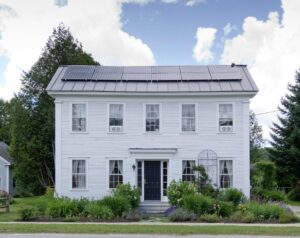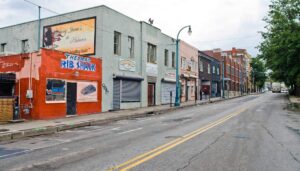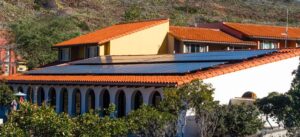Campus Solar Installations and Historic Preservation Raise Tough Issues of Climate Change, Aesthetics, and Equity
Looking up at the sun-soaked dome of Johnson Hall, the historic main building at the center of the Meredith College campus, I imagined it could be the perfect candidate for a solar installation project. What I didn’t know was that historic buildings have a history of meeting energy efficiency improvements with a full stop. My hopes for the residence halls and main academic buildings giving visibility to the dedication Meredith students have for clean energy were reduced to nothing. I wanted to know why.
 On Meredith’s campus it has been difficult for students and faculty who care about sustainability to gain any headway for a proposal to add solar panels atop the roofs of academic buildings. The problem? Older, lovely buildings, including Johnson Hall and residence halls, are eligible to be preserved and protected as historic sites.
On Meredith’s campus it has been difficult for students and faculty who care about sustainability to gain any headway for a proposal to add solar panels atop the roofs of academic buildings. The problem? Older, lovely buildings, including Johnson Hall and residence halls, are eligible to be preserved and protected as historic sites.
I ran into this thorny issue my freshman year at Meredith as I began my RCC Fellowship project. I searched for potential opportunities to integrate solar panels where students walking to class could see them. From the start, setting the stage for solar panels to be installed on campus and making sustainability a highly visible priority was my goal. But as I have worked to develop solar at Meredith with its stately older buildings, I have come to understand that around the nation, trying to both preserve and make historic buildings sustainable raises deeper issues of equity arising from efforts to get clean energy to combat climate change.
My deeper understanding began with the realization that pushing for pockets of consistent visibility that allow students to learn more about renewables and immediately observe evidence that students and staff are invested in clean energy sources is vital to future solar investments. Nationally, campus solar installations could make a huge difference. According to a Stanford University study, “Educational institutions account for approximately 11 percent of energy consumption by U.S. buildings and some 4 percent of the nation’s total carbon emissions.” It is important that universities in particular tackle the obstacles to getting renewable energy — access to funding, non-profit rebates, tax cuts and grants. These would make it easier for colleges to realistically develop ideas and projects that would decrease their reliance on dirty energy sources, while minimizing the likelihood that in the process they will break the bank.
But that first solar installation on a campus full of drastically different structures is as difficult to solidify as it has been important to pursue. Though the first step of future investment comes with the uncertainty of tentative brainstorming sessions and a string of meetings with connections and experts in the field, looking back it was somewhat inevitable that solar would not begin its expansion at Meredith with an expensive residence hall project. Nor was a plan for solar arrays across the rooftop of the Science and Math Building ever a feasible option. As much as it would have benefitted the institution in the long run, the initial investment costs doomed the large-scale proposal from the start.
The name of the game, as is often the case on college campuses, is laying the essential groundwork for such costly future projects — especially when historic construction and design is at play. Relentless navigation through the tilted roofs, limited space, irregular positioning, and domed rooftop of Johnson Hall, for which I once had such high hopes, has proven to be a long-term project.
With older projects, this seems to be a common theme. It is no secret that older historic buildings with their fragile adornments and irregular shapes — objects of antiquity, beauty and intricate craftsmanship — pose problems for property owners who want to decrease their reliance on fossil fuels and improve the health of their local community by reducing toxic emissions and particulate pollution. But the difficulty is not just structural irregularities, but a stringent code of rules and regulations put in place by Registers of Historical Sites. When a property is listed in the historic register, it is denied the ability to be visibly modified in any way that destroys its “historical” integrity.
As Patrice Frey, President & CEO of the National Main Street Center, explains in her article, “Why Historic Preservation Needs a New Approach,” sites or buildings are historically significant only if they completely comply with a certain set of standards. If they do not entirely comply, they are deemed not historically significant. Although the benefits of solar and the reduction of fossil fuel reliance through solar panel installations greatly outweigh the arguments against them, once buildings are preserved as historic sites, there are competing opinions about how a site should be maintained. Worse, there is an absence of flexible, multi-faceted approaches to the needs of both history and the current uses of any building. This lack of flexibility seriously limits the modifications that can be made to an historic site’s exterior, even if they are for the better.
Avoiding complicated restrictions and setbacks on old buildings is not just an issue for campuses. Interest in solar is spreading quickly among owners of both new and older properties who search for ways to cut costs and become more energy efficient. Properties characterized by newer construction have less red tape in their way; older buildings, especially those listed under registries of historic significance, face an uphill battle navigating the limitations if a property owner wishes to undertake a project that would alter the visual appearance of the structure.
Those property owners eager to make the transition to renewable energy and implement solar power are forced into a bind when the tax credits and grants their property is eligible for are compromised through listing under the National Register of Historic Places. One of a number of specific obstacles is called an historic preservation easement — a deed or agreement which permanently protects a historic location from future demolition or damage to its cultural significance. According to the U.S. Department of the Interior’s Technical Preservation Services, such easements are tax benefits for original owners who can then create permanent barriers to modifying historic buildings.
“Through the easement, a property owner places restrictions on the development of or changes to the historic property, then transfers these restrictions to a preservation or conservation organization. A historic property owner who donates an easement may be eligible for tax benefits, such as a Federal income tax deduction.”
 But even these restrictions have not stopped environmentally progressive property owners from continuing to search for ways to make sustainable home and building improvements. One promising avenue is to start a conversation in historic communities about the importance of skillfully integrating renewable energy into historic design. Reducing the visibility of solar panels is a main focus that helps ease the pressure of strict preservation regulations. Emphasizing minimal visibility of solar panels reduces the “eyesore” associated with the PV installations. Nevertheless, there is still a major discrepancy between distaste for visible solar panels on a historical structure and the improvements that visibly reveal direct actions toward reducing fossil fuel use in local communities.
But even these restrictions have not stopped environmentally progressive property owners from continuing to search for ways to make sustainable home and building improvements. One promising avenue is to start a conversation in historic communities about the importance of skillfully integrating renewable energy into historic design. Reducing the visibility of solar panels is a main focus that helps ease the pressure of strict preservation regulations. Emphasizing minimal visibility of solar panels reduces the “eyesore” associated with the PV installations. Nevertheless, there is still a major discrepancy between distaste for visible solar panels on a historical structure and the improvements that visibly reveal direct actions toward reducing fossil fuel use in local communities.
Visibility also stimulates critical conversations about what it means to preserve the aesthetic favored by government organizations such as the Department of the Interior’s Standards for the Treatment of Historic Properties. Interior’s conformity to a rigid set of paradigms which define the standards of historical integrity and aesthetics overshadows the crucial goal of preserving historical monuments as nuanced symbols of our shared past. Preservation has roots in inequality and unequal representation. As Americans increasingly struggle to confront the realities of racial injustice and economic inequity in our past and present, The National Trust for Historic Preservation acknowledges that not all types of history are included in the process of historic preservation, and not all needs for cultural preservation and representation are met.
“The preservation movement is also struggling to tell the full American story. Only eight percent of National Register sites and three percent of our National Historic Landmarks represent people of color, women, or members of the LGBTQ community.”
When considering historic site regulations from this perspective, it is difficult to see how traditional preservationists can continue to deny what is best for all members of a community. In order to truly fight injustice and cultural inequality, we must all face the fact that some members of our community are far more vulnerable to the effects of fossil fuel emissions, polluted resources, and health problems connected to climate distress.
There is something deeply wrong here that needs to be addressed. The placement of solar panels on historic buildings at Meredith College is an issue that I can work on directly. But such local efforts also lead directly to understanding that we must confront the larger issues raised by clinging to traditional, cramped notions of aesthetics and the representation of our history. Such rigidity prevents restoring older properties and communities creatively and inclusively in order to recognize the realities and diversity of our history. Such a pinched perspective ultimately promotes greater inequity and failure to combat climate change.
Recognizing a more inclusive history and the need to restore older buildings and communities in equitable and sustainable ways needs to be brought to the forefront of national debate. The health of our climate requires that we reduce our carbon dioxide emissions and toxic fossil fuel pollutants. The reason to install solar panels transcends aesthetics: solar provides communities with clean energy and progress. Solar reduces the need to rely on fossil fuels for sources of power, eliminating the toxic emissions and resulting pollutants produced from nonrenewable energy production that poisons a community’s air, water and natural resources. Indeed, our diverse cultural and historical foundations themselves are at stake unless we allow individuals, institutions and communities to invest in cleaner sources of energy. If we do not allow these changes to emerge and flourish, are we not robbing our historic communities of the clean environment and healthy future that would secure the safety of all our citizens and our shared historic landmarks?
To create such a transformation, the restoration, renovation and reconstruction of older, and often poorer, communities will require public as well as private investment and what has been called authenticity. Authenticity in community development and restoration means meeting the needs of a community and representing its history without romanticization, creating an architectural, aesthetic, and economic culture that is not stagnant and frozen in time – one that is dynamic, diverse and constantly changing as communities themselves change.
True authenticity is realistic. It recognizes that there are gradations between a truly “frozen in time” historical site and one that is a restored, adapted, sustainable and usable as a contemporary site. I believe it is necessary to move forward toward a more diverse American story that represents all of us. That story can continue best through the expressed physical representation of a shared heritage.
For higher education, (there are approximately 4,298 institutions in the US alone) efforts for renewable energy integration like solar are not just the framework for a good marketing plan, or a smart move to lower energy bills. It is essential to keep these historic buildings, with all their maintenance requirements and costs, relevant and valuable in the local community. As leaders in the community for forward-thinking innovation and for the education of future generations of students, campus administrators and leaders have a responsibility to demonstrate the necessity, accessibility, and visible impact of clean energy as a crucial mechanism to mitigate carbon emissions.
With all this in mind, I think back to a conversation I had with my mom, who worked and volunteered for many years at the Historic Preservation Foundation in North Carolina. From her experience, the demolition of historic sites is all too frequent. The lack of investment and care that these sites deserve in order to preserve a legacy in our communities of craftsmanship and care, requiring significant investment in time and skill, mirrors, perhaps too closely, the neglect of global climate health.
“Solar should be looked at like plumbing, A/C or electrical. It should be seen as essential, for functionality and longevity in a house, especially for the longevity of a historic home. It’s so important to look at energy efficient modifications this way because it helps historic places maintain their relevance and their importance in the community. By easing up on the stringent restrictions that try to maintain complete historic accuracy and allowing the owners of historic properties to make changes that would increase energy efficiency, we might prevent these sites from being demolished. These changes are inevitable anyway — whether historic preservation will be a factor in the equation going forward or not.”
We have an obligation to preserve our environment. At the same time, we owe it to future generations to also preserve the pieces of cultural heritage that still stand in our communities. We shouldn’t have to pick between the old and the new. Older, even deteriorating, sites can be filled with new life and be resurrected as centerpieces of local communities if they are allowed to modernize in essential ways. They have the potential to become examples of sustainable integration. Which do we consider more important? Clinging to an unyielding and incomplete perspective of history, or doing all we possibly can to see history with a wider lens and offering historic buildings the chance to become energy efficient and, thus, invaluable to sustainability, well-being and equity within our communities.
Emma Fry – Rachel Carson Council Fellow
 Emma Fry is a junior at Meredith College pursuing a double major in Environmental Science and Biology with a minor in Professional Writing. Her RCC Fellowship project is promoting solar energy on campuses. [email protected]
Emma Fry is a junior at Meredith College pursuing a double major in Environmental Science and Biology with a minor in Professional Writing. Her RCC Fellowship project is promoting solar energy on campuses. [email protected]
![]() The Rachel Carson Council depends on tax-deductible gifts from concerned individuals like you. Please help if you can.
The Rachel Carson Council depends on tax-deductible gifts from concerned individuals like you. Please help if you can.
![]() Sign up here to receive the RCC E-News and other RCC newsletters, information and alerts.
Sign up here to receive the RCC E-News and other RCC newsletters, information and alerts.










